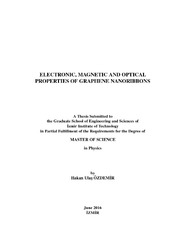Please use this identifier to cite or link to this item:
https://hdl.handle.net/11147/2830Full metadata record
| DC Field | Value | Language |
|---|---|---|
| dc.contributor.advisor | Güçlü, Alev Devrim | - |
| dc.contributor.author | Özdemir, Hakan Ulaş | - |
| dc.date.accessioned | 2017-01-20T11:02:29Z | |
| dc.date.available | 2017-01-20T11:02:29Z | |
| dc.date.issued | 2016-06 | - |
| dc.identifier.citation | Özdemir, H. U. (2016). Electronic, magnetic and optical properties of graphene nanoribbons. Unpublished master's thesis, İzmir Institute of Technology, İzmir, Turkey | en_US |
| dc.identifier.uri | http://hdl.handle.net/11147/2830 | - |
| dc.description | Thesis (Master)--Izmir Institute of Technology, Physics, Izmir, 2016 | en_US |
| dc.description | Includes bibliographical references (leaves: 51-56) | en_US |
| dc.description | Text in English; Abstract: Turkish and English | en_US |
| dc.description | x, 56 leaves | en_US |
| dc.description.abstract | In this thesis, electronic, magnetic and optical properties of graphene nanoribbons are investigated within mean-field Hubbard model with two different disorder type; long and short range in finite and cyclic topology. First we investigated combined effect of electron-electron interaction effects and long range potential fluctuations. In both of the geometries, electron-electron interaction effects make edge states robust against disorders. Furthermore, surprisingly, strong enough disorder causes system to experience a phase transition from antiferromagnetically coupled edge states to ferromagnetic coupling in agreement with recent theoretical and experimental studies. Then, the stability of optical conductance under impurity effects, correlation between optical characteristic and magnetic phase of ZGNR is investigated, respectively. Similar to edge state density profile recovery, electronic interaction effects reduce the impurity induced peak around Fermi level. More importantly, we found distinct optical transitions due to edge-bulk mixed states around Fermi level that can be used to detect whether ZGNR is in antiferromagnetic or ferromagnetic phase. Finally, we investigated the disorder induced metalinsulator transition. Since, long range impurities protect the sublattice symmetry and leads to phenomena known as ”absence of backscattering”, there exist minimum conductivity for graphene. On the other hand, in order to model hydrogenation effects, we used short range impurity potential which breaks the sublattice symmetry. Using a time dependent tight binding model, we observed Anderson localization induced metal to insulator transition with a nanometer scale localization length for 2% hydrogen coverage. We found that, Anderson localization is stronger at high energy valence states since those states are more vulnerable to hydrogenation. | en_US |
| dc.description.abstract | Bu tezde, ortalama-alan Hubbard modeli kullanarak zigzag kenarlı grafen nanoşeritlerin (ZGNŞ ) elektronik, manyetik ve optik özelliklerini iki farklı geometride inceledik: sonlu ve çembersel. İlk olarak elektron-elektron etkileşiminin ve uzun mesafeli potansiyel düzensizliklerinin etkisi üzerine çalıştık. İki geometride de elektron-elektron etkileşiminin kenar durumlarını düzensizliklere karşı güçlü kıldığını ve şasırtıcı şekildedüzensizlik yeterince güçlü olduğunda antiferromanyetik durumdan ferromanyetik duruma faz geçişini tetiklediğini gördük. Bu sonuçlar, güncel kuramsal ve deneysel çalışmalarla örtüşmektedir. Daha sonra ZGNŞ ’te düzensizliğin optik iletkenliğe etkisini inceledik. Önceki sonuçlarda olduğu gibi elektron-elektron etkileşiminin düzensizlik etkisini azalttığını gördük ve daha da önemlisi, Fermi seviyesine yakın bölgede bulunan kenar-yığın karışımı durumlar arası optik geçişten kaynaklanan soğurma karakteristiğinin sistemin manyetik fazını belirlemede kullanılabileceğini gösterdik. Son olarak, düzensizliklerin metal-yalıktan geçişine olan etkisini inceledik. Fakat, uzun mesafeli potansiyel dalgalanmaları alt-ağ simetrisini koruduğu ve geri saçılmadan yoksunlaştırdığı için, grafende minimum iletkenliğe sebep olurlar. Bu durumdan kurtulmak ve hidrojenlenme etkisini modelleyebilmek için, kısa mesafeli düzensizlikler kullandık ve alt-ağ simetrisini kırmayı başardık. Zamana bağlı sıkı bağlanma modeli kullanarak Anderson lokalizasyonunundan kaynaklı metal-yalıtkan geçişini nanometre düzeylerinde lokalizasyon uzunluğu olduğunu %2 hidrojen kapsaması kullanarak gözlemledik. Anderson lokalizasyonun etkisinin yüksek enerjili valans bandlarında, düzensizlik durumlarinin bu bölgeye toplanmasından dolayı, diğer band bölgelerine göre daha fazla olduğunu gözlemledik. | en_US |
| dc.language.iso | en | en_US |
| dc.publisher | Izmir Institute of Technology | en_US |
| dc.rights | info:eu-repo/semantics/openAccess | en_US |
| dc.subject | Condensed matter physics | en_US |
| dc.subject | Solid state physics | en_US |
| dc.subject | Nanophysics | en_US |
| dc.subject | Graphene | en_US |
| dc.title | Electronic, Magnetic and Optical Properties of Graphene Nanoribbons | en_US |
| dc.title.alternative | Grafen Nanoşeritlerin Elektronik, Manyetik ve Optik Özellikleri | en_US |
| dc.type | Master Thesis | en_US |
| dc.institutionauthor | Özdemir, Hakan Ulaş | - |
| dc.department | Thesis (Master)--İzmir Institute of Technology, Physics | en_US |
| dc.relation.publicationcategory | Tez | en_US |
| dc.identifier.wosquality | N/A | - |
| dc.identifier.scopusquality | N/A | - |
| item.openairecristype | http://purl.org/coar/resource_type/c_18cf | - |
| item.languageiso639-1 | en | - |
| item.openairetype | Master Thesis | - |
| item.grantfulltext | open | - |
| item.fulltext | With Fulltext | - |
| item.cerifentitytype | Publications | - |
| Appears in Collections: | Master Degree / Yüksek Lisans Tezleri | |
Files in This Item:
| File | Description | Size | Format | |
|---|---|---|---|---|
| T001463.pdf | MasterThesis | 9.08 MB | Adobe PDF |  View/Open |
CORE Recommender
Page view(s)
320
checked on Mar 31, 2025
Download(s)
214
checked on Mar 31, 2025
Google ScholarTM
Check
Items in GCRIS Repository are protected by copyright, with all rights reserved, unless otherwise indicated.